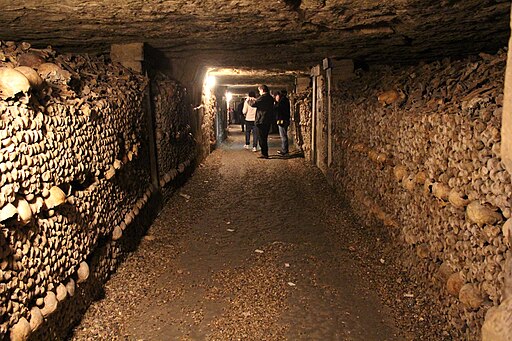History
Although the Catacombs may seem like an extraordinarily large and creepy pile of old bones, the history and significance of the Catacombs is fascinating! In fact, there are thought to be a few graves seen there of some pretty interesting characters, including the highly iconic writer Charles Perrault (author of Cinderella), who was thought to have had his skeletal remains transferred. Other iconic figures who were thought to have had their remains transferred to The Catacombs include some of the most important influences in the French Revolution – Jean-Paul Marat and Maximilien de Robespierre.


Some believe that there are remains of victims of the Black Death (bubonic plague and pneumonic plague) that swept Europe in the Middle Ages. However, it is very difficult for archeologists and scientists to sufficiently determine what happened individually to each skeleton found in The Catacombs today. However, it is clear that many of the Paris cemeteries that were emptied in the Catacombs in the 18th and 19th centuries were known to have many remains from Black Death victims.
Key Terms:
- Catacombs – A cemetery underground.
- Bubonic Plague – A deadly mass plague during the Middle Ages that was caused by a bacteria that was transmitted through the bites of fleas.
- Les Innocents – A suburban Paris cemetery where many of the skeletons from the catacombs were originally buried.
- Charles Perrault – An icon in children’s literature, French writer Charles Perrault is attributed to writing classics like “Sleeping Beauty” and “Cinderella”. His skeleton remains are thought to have been moved to the catacombs in Paris.
- French Revolution – The French Revolution happened in 1878, which led to the end of an absolute monarchy that reigned over 900 years.
- Limestone – A soft rock and important building material in Paris until the twentieth century. Layers of limestone can be found in the catacombs in Paris.
- Campanile giganteum – An ancient gigantic gastropod, whose fossil has been found in the French basin.
- Merovingians – An older dynasty of Frankish kings from the 5th to the 8th centuries.
- Paris Quarries – Underground mines in Paris.
- Tuffeau – A type of white limestone used in the construction of many French castles.

The most interesting part of the Catacombs is the how and why they were constructed. It all started as a way to address a major public health crisis in the 18th century, when the cemeteries in Paris began to massively overflow – literally! In some areas, coffins were starting to move up out of the ground due to the overflow of bodies. Due to this a putrid smell began to permeate through the city of Paris. This did not just lead to extremely unpleasant living conditions. This also could lead to increasingly unsanitary situations for Parisian citizens.
The solution to this was the mass evacuation of these bodies into a large deep underground quarry, whose rich limestone was originally dug up for building material. The rich limestone that can be found in the Catacombs and many other Paris quarries also has a significant history. Many of the most famous structures that were built in Paris up until the 20th century were built by limestone (mostly Tuffeau) that was dug up from deep quarries.

This Tuffeau limestone was formed during the Mesozoic era, about 90 million years ago. About 45 million years ago, the city of Paris was covered by a tropical ocean with many diverse marine life. This makes this soft limestone filled with some magnificent and perfectly preserved fossils. Some of the most interesting fossils that have been discovered in the limestones of the Catacombs include the shell of the large ancient gastropod Campanile giganteum and molds of cerith snails. These fossils can also be easily seen in several Paris monuments that were built in the medieval period.
You will need:
- A sturdy background (like popsicle sticks or cardboard).
- Glue (regular school glue should be fine).
- Spiral pasta for the spine.
- Shell pasta for joints and eye sockets.
- Thin pasta like spaghetti for limbs, fingers, and toes.
- Macaroni for pelvic bone, ribs, mandible, and cranium.
To decorate:
Make sure to have a sturdy background for your skeleton. This can be done by gluing large popsicle sticks together. Let them dry completely before adding pasta skeletons. Use the pasta available to make some really cool skeletons!
Works Cited:
- “7 Facts about the Black Death of 1348 in Paris.” Discover Walks Blog, 22 Mar. 2021, https://www.discoverwalks.com/blog/paris/7-facts-about-the-black-death-of-1348-in-paris/.
- “Catacomb: Meaning & Definition for UK English.” Lexico Dictionaries | English, Lexico Dictionaries, https://www.lexico.com/definition/catacomb.
- Doyle, Sebastian. “The Catacombs of Paris: Introduction and Construction.” Mysterium Tours, 22 Oct. 2020, https://www.mysteriumtours.com/the-catacombs-of-paris-introduction-and-construction/.
- GavinTheCop. “Paris Catacombs.” – Writer of Authentic Hard Boiled Thrillers –, 16 Aug. 2019, https://gavinreese.com/2019/08/16/paris-catacombs/.
- “Geology and the Quarries.” Catacombes, https://www.catacombes.paris.fr/en/history/geology-and-quarries.
- “History of the Catacombs of Paris.” Come to Paris, 1 Jan. 1065, https://www.cometoparis.com/paris-guide/paris-monuments/the-catacombs-of-paris-s955.
- Magazine, Smithsonian. “Beneath Paris’ City Streets, There’s an Empire of Death Waiting for Tourists.” Smithsonian.com, Smithsonian Institution, 28 Mar. 2014, https://www.smithsonianmag.com/travel/paris-catacombs-180950160/.
- “Paris’ Les Innocents Cemetery.” Paris, https://www.paris-promenades.com/en/site_text/III.htm.
- Perrault, Charles. “Charles Perrault Fairy Tales.” Welcome to Charles Perrault’s Fairy Tales Page!, World of Tales, 1 Jan. 1970, https://www.worldoftales.com/fairy_tales/Perrault_fairy_tales.html#gsc.tab=0.
- Robin, Sylvie, et al. The Catacombs of Paris: An Underground World. Les Musées De La Ville De Paris, 2019.\
- Turner, Steve. The Most Majestic French Limestone, https://info.amarestone.com/blog/the-most-majestic-french-limestone.
- Winter, Niels J. de, et al. “The Giant Marine Gastropod Campanile Giganteum (Lamarck, 1804) as a High‐Resolution Archive of Seasonality in the Eocene Greenhouse World.” AGU Journals, John Wiley & Sons, Ltd, 2 Apr. 2020, https://agupubs.onlinelibrary.wiley.com/doi/abs/10.1029/2019GC008794.

